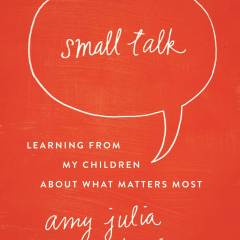 It’s that time of year when many Christians navigate an uneasy path, trying to remember that “Jesus is the reason for the season” when so much of the season revolves around secular activities like decking the halls, leaving cookies for Santa, and belting out songs about a uniquely gifted reindeer.
It’s that time of year when many Christians navigate an uneasy path, trying to remember that “Jesus is the reason for the season” when so much of the season revolves around secular activities like decking the halls, leaving cookies for Santa, and belting out songs about a uniquely gifted reindeer.
Author Amy Julia Becker used to be one of those people who worried about “keeping Christ in Christmas.” When her children started coming — she now has three — she tried valiantly to separate the sacred and the secular. Her kids would not conflate Santa Claus with God, or regard Jesus’ birthday as an excuse for hedonistic spoiling.
As she describes in her beautiful new memoir Small Talk: Learning from My Children About What Matters Most, she did her best to put Christ in Christmas by underscoring the religious message of the holiday (Advent calendars, stuffed animal nativity scenes, church carols instead of “Santa Claus Is Comin’ to Town”) and de-emphasizing the focus on presents. Maybe she should just give each child one gift?
What changed her mind about Christmas was her kids.
Sure, they were as interested as any other kids in presents, and special holiday foods, and school parties, and did we mention the presents? But they also knew a thing or two about pure, unadulterated joy – something adults like Becker, and like me, could stand to learn a thing or two about. When her daughter Penny came home singing “Jingle Bell Rock” with an almost worshipful joy, Becker recognized that for Penny, there was no dividing line between the sacred and the profane.
Maybe, she realized, her attempts to carefully separate “Christian Christmas” and “American Christmas” were theologically misguided:
I think back to the way Jesus’ birth upended traditional assumptions that the spiritual world and the physical world must remain distinct spheres. Jesus’ birth signaled the entrance of God into time and space. And despite Jesus’ condemnation of evil, his life attests to his ongoing affirmation of the goodness of our physical reality. This is the man who changed water into wine so the party could continue . . .
Jesus was concrete, physical, tangible — not a pie-in-the-sky deity who could not be bothered with human mess or human joy. In the person of Jesus, the sacred and the secular fused in a new and powerful way. Why should our celebration of Christmas be any different?
Christmas, Becker finds, cannot be “purely” religious. Rather, it’s an example of how the sacred consecrates the profane. When we bake gingerbread cookies or dress in fancy clothes, “we are acknowledging a spiritual truth made manifest on Christmas morn. We are participating in God’s declaration that this world matters enough to enter into it, to upend the evil within it, to hold tight to the good, forever.”
That, in a nutshell, is what Incarnation means.
The Word became flesh, and dwelt among us. Pass the eggnog.
 And speaking of Christmas, Amy Julia Becker’s latest book, Small Talk: Learning from My Children About What Matters Most, would make a terrific holiday gift for parents and anyone who is interested in what children can teach us about God.
And speaking of Christmas, Amy Julia Becker’s latest book, Small Talk: Learning from My Children About What Matters Most, would make a terrific holiday gift for parents and anyone who is interested in what children can teach us about God.
It’s a beautifully written combination of memoir and theology, both accessible and thought-provoking. Take a look.






